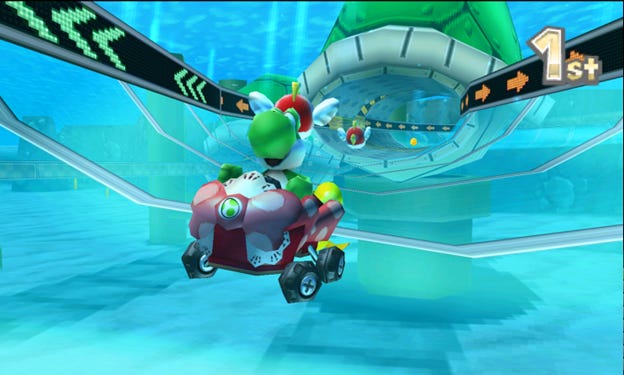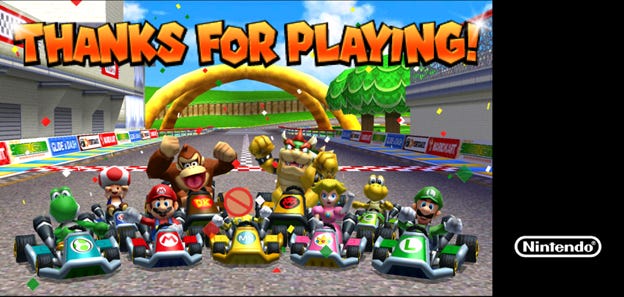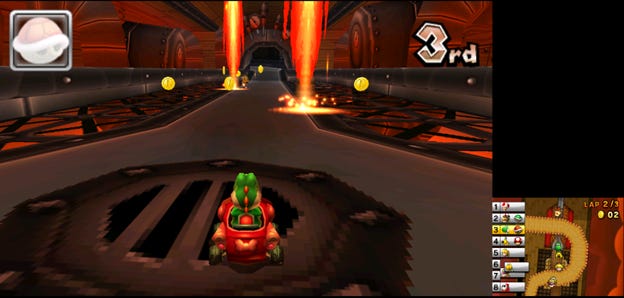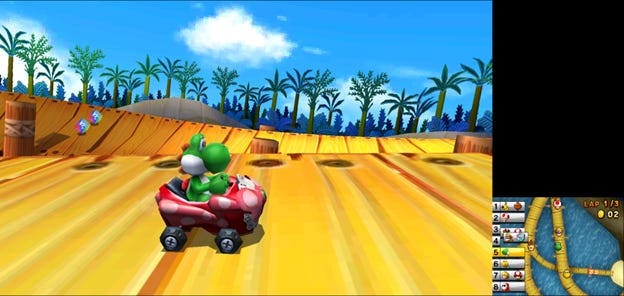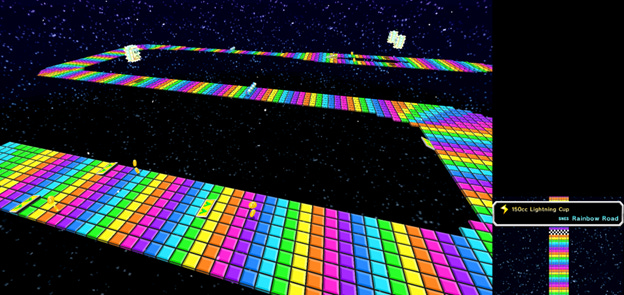Hey all! Sorry if my voice sounds a little different, I had a cold while I was writing this. Welcome back to Mario Kart 7. Last time, we won the Special Cup, this time we run the final prix: the Lightning Cup!
Not much to say about my own gameplay this time around. This time I optimized for handling, but didn’t really pay much attention to the other stats. I mistook a hole in the track for the way to go in Airship Fortress, got karted because of it, further solidifying this as my least favorite course. Other than getting hit by a blue shell at the very end of close race yet still winning on Koopa Cape, nothing else of note happened and I came first overall.
Then, the credits rolled, and we’re thanked for playing.
Thanks for playing. What an interesting phrase. On top of expressing the developers’ gratitude, it also acknowledges how the game cannot happen without the player. It’s a simple yet important message that I’m glad to see becoming more common.
But to tell you the truth, when I first saw it, I didn’t like it.
You see, when teenage me finished the game for the first time and saw the thank you screen, he felt a little insulted. It felt like “Thanks for Playing” carried the implication that I was done playing and wouldn’t play it again. As I’ve said before, though, Mario Kart is designed to be replayed. And the fact that it’s the first game I’m covering here is evidence that it is worth replaying. So the disconnect between what I was feeling and what I thought the words implied just rubbed me the wrong way.
Honestly, that was pretty petty of me, and at least part of me acknowledged that it was a nice thing to say, but I’ll never forget that that’s what I thought at the time. Whenever you communicate, there’s a chance people will interpret what you say differently from what you mean. And when you communicate to people en masse, like through a video game, that chance almost always becomes a given. What my misinterpreting “Thanks for Playing” shows is that no matter how obvious or well-communicated your meaning is, someone’s bound to miss it, so if you do your best to communicate you shouldn’t worry about a few people not understanding.
Anyway, nowadays, I like the phrase a whole lot more. For one thing, without players, there’d be no games, so it’s good to see their importance acknowledged by the game. For another, seeing it more and more made me get used to it. But most importantly, since first playing MK7, I’ve become a dev myself. It means a lot to me that someone would take the time out of their day to play my game, and I truly am thankful to anyway who does. (As a side note, please play my game.) So, now, I greatly appreciate such player appreciation, and I encourage any designers reading this to try to get it in their games.
Oh yeah, that reminds me, thanks for reading!
And so, our Mario Kart 7 journey crosses the finish line. It was a fun and interesting ride, certainly more than I had expected. I learned a lot by playing and writing about it, and I hope you learned too by reading it. Or at the very least, that I convinced you to get out an old copy of MK7 and try it yourself.
As for the future of this blog, while it has been difficult and at times a bit tedious to write it, it’s mostly been a terrific experience and I’m very glad to finally be able to contribute something to the literature of game design.
As such, we’ll be kicking off next week with a brand new series. (Or maybe an intermission with something I’ve already mostly written, so I can have it off). I won’t be revealing what games will come next until I start their series, so you’ll have to wait until then.
But don’t worry, there’s plenty of things you could do in the meantime. You could go outside, touch some grass. Or you could stay indoors and look for a pretty meme. Maybe find an exquisite one to put in your collection. Whatever, I’m not your mom. Just go do something good, and I’ll be waiting for you in my den.
VIDEO OF THE WEEK: The origin of the term “karted”:




